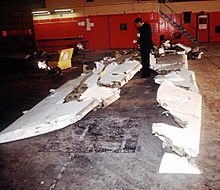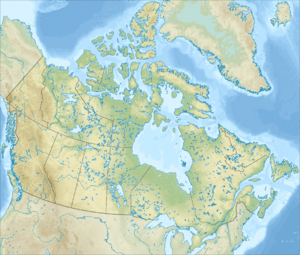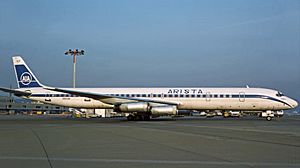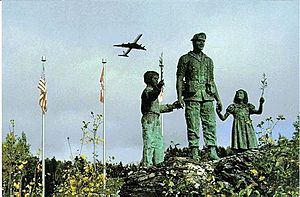Arrow Air Flight 1285R facts for kids

Wreckage from Arrow Air Flight 1285R in storage at a Gander Airport hangar on 16 December 1985
|
|
| Accident summary | |
|---|---|
| Date | 12 December 1985 |
| Summary | Icing conditions and pilot error as a result of weight and reference speed miscalculations leading to collision with trees |
| Place | Gander International Airport, Newfoundland, Canada 48°54′43″N 54°34′27″W / 48.91194°N 54.57417°W |
| Passengers | 248 |
| Crew | 8 |
| Fatalities | 256 |
| Survivors | 0 |
| Aircraft type | McDonnell Douglas DC-8-63CF |
| Airline/user | Arrow Air |
| Registration | N950JW |
| Flew from | Cairo International Airport, Egypt |
| Stopover | Cologne Bonn Airport, West Germany |
| Last stopover | Gander International Airport, Newfoundland, Canada |
| Flying to | Campbell Army Airfield, Kentucky, United States |
Arrow Air Flight 1285R was a McDonnell Douglas DC-8 jet airplane. It was a special flight carrying U.S. soldiers from Cairo, Egypt, back to their base in Fort Campbell, Kentucky. The flight had stops in Cologne, West Germany, and Gander, Newfoundland.
On the morning of Thursday, December 12, 1985, the plane took off from Gander. Soon after, it lost control, crashed, and caught fire about half a mile from the runway. All 248 passengers and 8 crew members on board died. This accident is the deadliest plane crash ever to happen in Canada. It was also the deadliest accident involving a DC-8 plane at that time.
The Canadian Aviation Safety Board (CASB) investigated the crash. They believed the main reason for the crash was ice on the plane's wings. This ice would have made it harder for the plane to fly. They also thought the plane might have been heavier than estimated. However, some investigators had a different idea. They thought an explosion might have happened on the plane before it crashed. This disagreement caused delays in making new rules for removing ice from planes.
Because people lost trust in the CASB's investigations, the Canadian government closed it down in 1990. They created a new, independent group called the Transportation Safety Board of Canada to investigate accidents.
Contents
Flight Details: What Happened?
The plane involved was a McDonnell Douglas DC-8-63CF. It was rented to carry U.S. Army soldiers, mostly from the 101st Airborne Division. These soldiers were returning home after six months of peacekeeping duty in the Sinai Peninsula.
The flight had three parts. It started in Cairo, Egypt, on December 11, 1985. It then flew to Cologne, Germany, for a stop. A new flight crew took over there. This crew included Captain John Griffin, First Officer Joseph Connelly, and Flight Engineer Michael Fowler.
The plane then flew to Gander International Airport in Newfoundland. The passengers got off while the plane was refueled. Witnesses said the flight engineer checked the outside of the plane. After that, the passengers got back on board.
The DC-8 started to take off from Gander at 6:45 AM local time. It struggled to gain height after leaving the ground. The plane's speed went up but then dropped again, causing it to go lower.
Witnesses on a nearby highway saw the plane flying very low. They also saw a bright glow coming from the aircraft. The plane then hit the ground near Gander Lake and crashed. It broke apart, hit an empty building, and exploded. A large fire started because of all the fuel on board. All 256 people on the plane died.
Investigating the Crash
The Canadian Aviation Safety Board (CASB) looked into the crash. Five of the nine board members believed that ice on the wings was the main problem. They said that when the plane landed in Gander, there was freezing rain and snow. This weather was perfect for ice to form on the plane's wings. They also found that the plane was not de-iced before it took off.
The board's main conclusion was that the plane had trouble flying because of "ice contamination" on its wings. This ice made the plane lose lift and gain drag, causing it to stall at a low height. They also thought other things, like a possible problem with one engine or incorrect takeoff speeds, might have made the situation worse.
However, four of the nine CASB members disagreed. They wrote a separate report saying there was no clear proof of ice on the wings. They thought that an "in-flight fire" or "explosions" might have caused the plane to crash. One of these investigators later said that a thin layer of ice could not bring down such a large plane.
The investigation also found problems with the plane's flight recorders. The old flight data recorder only saved basic information like speed and altitude. The cockpit voice recorder, which records sounds in the cockpit, did not work. This meant investigators could not hear what the pilots were saying.
Because of the disagreements and lack of trust in the CASB's findings, the Canadian government decided to close the board. They then created the Transportation Safety Board of Canada in 1990. This new board is independent and investigates all types of transportation accidents.
After the Accident

On the day of the crash, a group claimed they were responsible. However, both the Canadian and U.S. governments quickly said this claim was not true.
All 256 people on board died. This remains the deadliest plane crash in Canada's history. It was also the U.S. Army's worst air crash during peacetime.
Most of the soldiers who died were from the 101st Airborne Division (Air Assault).
There are memorials to the victims. One is at the crash site overlooking Gander Lake. Another memorial was built at Fort Campbell, Kentucky. There is also a Memorial Park in Hopkinsville, Kentucky. Even today, you can still see the mark left by the crash on the ground.
The disagreement about the cause of the crash, especially the idea that a thin layer of ice could bring down a plane, caused delays in changing de-icing rules. Later, in 1989, a thin layer of ice did cause another deadly crash in Canada, Air Ontario Flight 1363.
In Popular Culture
The TV show Mayday (also known as Air Crash Investigation) featured the Flight 1285R crash. The episode was called "Split Decision." It included interviews with investigators and a re-enactment of the accident.
The TV show Unsolved Mysteries also had an episode about the crash. This episode suggested that an explosion or fire on the plane might have caused the crash.
See also
 In Spanish: Vuelo 1285 de Arrow Air para niños
In Spanish: Vuelo 1285 de Arrow Air para niños






